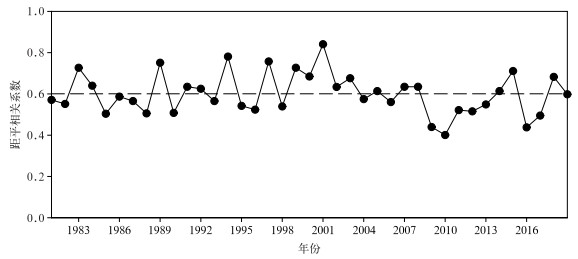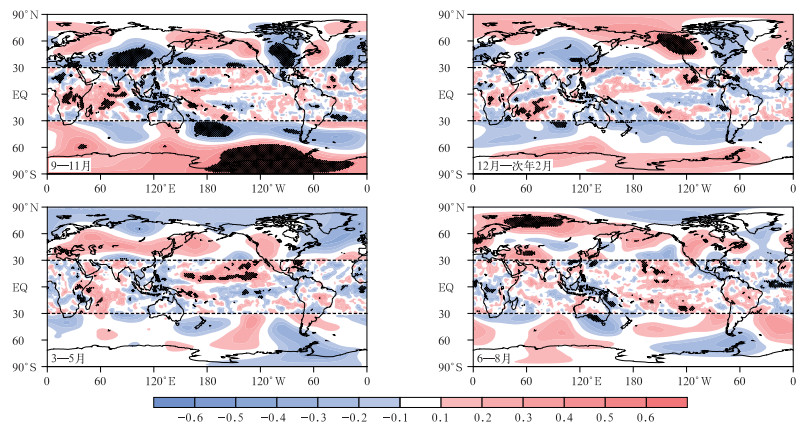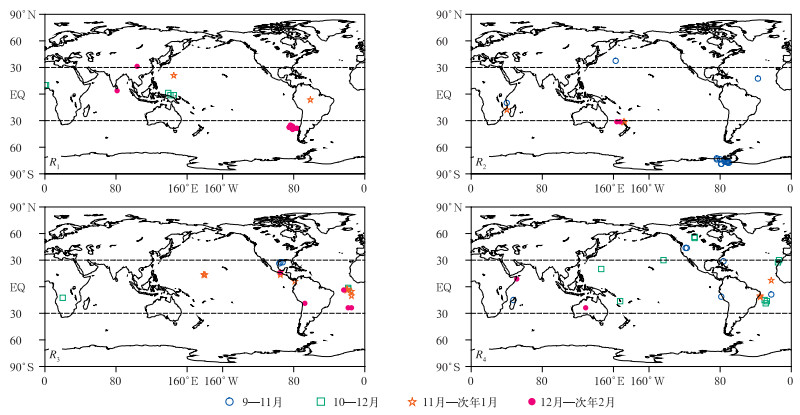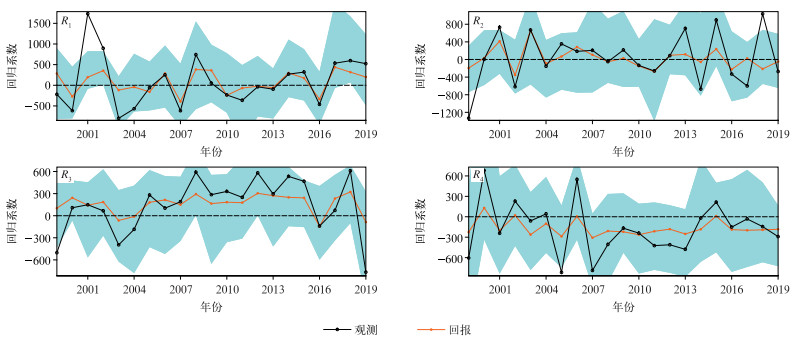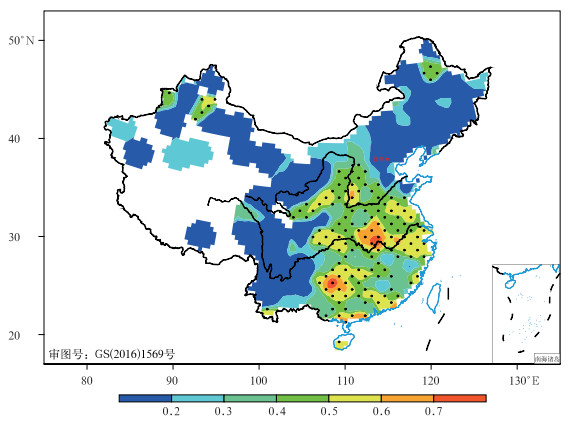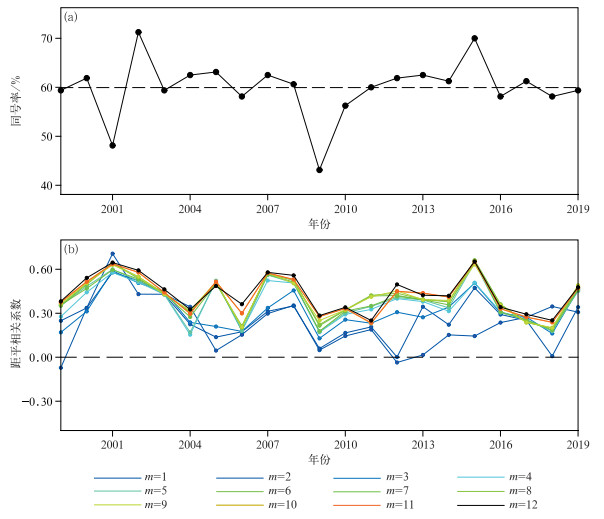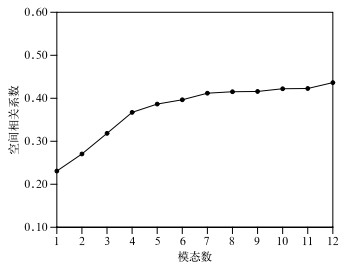Potential Skill Map of Predictors Applied to the Seasonal Forecast of Summer Rainfall in China
-
摘要: 影响我国夏季汛期降水异常的因子繁多,不同因子之间复杂的相互作用制约我国夏季降水季节预测水平。目前动力模式对降水预测技巧水平较低,如何开发客观统计预报方法,提高我国夏季降水预报技巧依然存在挑战。该文基于最小二乘法拟合和交叉检验方法,提出一种搜索预测因子潜在预测技巧的方法(潜在技巧分布图),并基于该方法开发预测因子自动选择器,建立中国夏季降水异常自动统计预测模型。与传统线性相关分析相比,潜在技巧分布图不受极端气候事件影响,可直观展现具有显著预测技巧的前兆信号,而预测因子自动选择器则能从潜在技巧分布图中自动筛选最优预测因子,获得逐年不同的预测因子,更符合中国夏季降水异常影响因子多样性的客观事实。在完全剔除预测当年信息的回报试验中,该预测模型对1999—2019年中国夏季汛期降水异常的历史回报技巧明显高于动力模式。通过方差订正,历史回报降水的PS评分从71.00分提高到82.10分,显示了该模型的潜在预报潜力。
-
关键词:
- 中国夏季汛期降水异常;
- 季节预测;
- 交叉检验;
- 潜在技巧分布图
Abstract: Anomalous summer rainfall in China is affected by many factors, whose complex interaction restricts the predictability of Chinese summer rainfall (CSR). The predicting skill of the state-of-the-art dynamic models on the CSR is still limited, leaving challenges in developing objective statistical predicting methods. A method for searching potential predicting skill of predictors (i.e., potential skill map, PSM) is proposed, which can be used to select predictors automatically based on the PSM, and a new automatic statistical prediction model of the CSR is established.Compared with traditional linear correlation analysis, the PSM using the cross-validation concept not only reflects the potential predicting skills of predictors on predictands, but is free from effects of extreme events. It is completely based on real-time statistical predicting procedure, which aims to find sufficient conditions for predictands in logical. The PSM is an important supplement to the traditional correlation coefficient map. They work together to provide potential predictors with necessary and sufficient conditions. The predictor automatic selector takes advantage of the idea of ensemble forecasting. It selects predictors with the most significant potential forecasting skill from the PSM, and then generates final forecast products by averaging a large number of predicting members. The year-by-year automatic selection of the predicators is thus realized. This solution doesn't rely on subjective experiences of foreasters, and also provides a new way to further investigate the predictability of the interannual variability of the East Asian summer monsoon. This new automatic statistical prediction model of the CSR based on the PSM and the predictor automatic selector shows a high reforecast skill for the CSR. In the 21-year reforecasting experiment from 1999 to 2019, predictors in the previous autumn and winter seasons are used to predict the CSR. Results show an average symbol agreement rate of 60% and the mean anomaly correlation coefficient of 0.436 between the reforecast and the observed CSR. As to the predicting skill (PS) score in the National Climate Center, the reforecast CSR reaches 71.00 in average. After variance correcting, the PS score further increases to 82.10, which is much higher than predicting skills of current dynamical models. It is noteworthy that the reforecast experiment in the present uses the first 12 multiple regression coefficients and EOF modes of the CSM, of which the first 4 multiple regression coefficients and EOF modes play a dominant role in the overall distribution of the CSM. By contrast, higher-order modes could further improve the reforecast skill by increasing the diversity of the reforecasting CSM, which represent their potential physical implications. -
图 1 基于1981—2019年EOF主模态和多元回归系数重构降水异常场和观测降水异常场(参考态)的泰勒图
(不同颜色的点表示基于不同数量EOF主模态和多元回归系数的重构结果)
Fig. 1 Taylor diagram of the reconstructed rainfall anomaly field based on EOF modes and multiple regression coefficients referring to the observation during 1981-2019
(dots in different colors denote reconstructed results using different numbers of EOF modes and principle components)
图 2 基于1981—2019年前12个EOF主模态和多元回归系数重构的降水异常场与观测逐站降水异常序列时间相关系数空间分布
(斜线和打点区分别表示达到0.05和0.01显著性水平)
Fig. 2 Correlation coefficient of reconstructed rainfall anomaly using the first 12 EOF modes and multiple regression coefficients to observed rainfall anomaly at each station during 1981-2019
(areas with significance exceeding 0.05 and 0.01 levels are slashed and stippled, respectively)
图 4 1999—2019年R2与不同季节预测因子的相关分布
(打点区表示达到0.05显著水平,预测因子包括30°S~30°N地区降水和南半球、北半球中高纬度地区200 hPa位势高度场)
Fig. 4 Spatial distribution of temporal correlation coefficient between the second regression coefficient(R2) and the predictors in different seasons during 1999-2019
(the stippled denotes passing the test of 0.05 level, predictors include the rainfall in 30°S-30°N and 200 hPa geopotential height in the mid-high latitude)
图 5 1999—2019年不同季节预测因子对R2的潜在技巧分布图
(打点区表示达到0.05显著性水平,预测因子包含30°S~30°N地区降水和南半球、北半球中高纬度地区200 hPa位势高度场)
Fig. 5 Potential skill map of the second regression coefficient(R2) referring to the predictors in different seasons during 1999-2019
(the stippled denotes passing the test of 0.05 level, predictors include rainfall in 30°S-30°N and 200 hPa geopotential height in the mid-high latitude)
图 6 预测因子自动选择器提取的1999—2019年前4个多元回归系数的预测因子热度图
(预测因子包含30°S~30°N地区降水和南半球、北半球中高纬度地区200 hPa位势高度场)
Fig. 6 Heat map of predictors of the first 4 multiple regression coefficients during 1999-2019 obtained by the predictor automatic selection scheme
(predictors include the rainfall in 30°S-30°N and 200 hPa geopotential height in the mid-high latitude)
图 9 预测模型对1999—2019年中国夏季汛期平均降水异常的回报检验
(a)采用前12个多元回归系数和EOF模态的回报结果相对于观测的同号率,(b)基于不同多元回归系数的回报结果相对于观测降水异常的空间相关系数的逐年变化(m表示前1~12个多元回归系数和EOF主模态的回报结果)
Fig. 9 Reforecast test of Chinese summer rainfall anomaly during 1999-2019 using new predicting method
(a)the same sign rate between reforecast and observation using the first 12 multiple regression coefficients and EOF modes, (b)anomaly correlation coefficients between observation and reforecast based on different numbers of multiple regression coefficients(m, ranging from 1 to 12, indicates the reforecast generated by different numbers of multiple regression coefficients and EOF modes)
-
[1] 李维京.现代气候业务.北京:气象出版社, 2012:202-203. [2] Wang B, Xiang B Q, Lee J Y.Subtropical High predictability establishes a promising way for monsoon and tropical storm predictions.PNAS, 2013, 110:2718-2722. doi: 10.1073/pnas.1214626110 [3] Li T, Wang B, Wu B, et al.Theories on formation of an anomalous anticyclone in western North Pacific during El Nio:A review.J Meteor Res, 2017, 31:987-1006. doi: 10.1007/s13351-017-7147-6 [4] Wang B, Wu R G, Fu X H.Pacific-East Asian teleconnection:How does ENSO affect East Asian climate?J Climate, 2000, 13:1517-1536. doi: 10.1175/1520-0442(2000)013<1517:PEATHD>2.0.CO;2 [5] Xie S P, Kosaka Y, Du Y, et al.Indo-Western Pacific Ocean capacitor and coherent climate anomalies in post-ENSO summer:A Review.Adv Atmos Sci, 2016, 33:411-432. doi: 10.1007/s00376-015-5192-6 [6] Yang J L, Liu Q U, Xie S P, et al.Impact of the Indian Ocean SST basin mode on the Asian summer monsoon.Geophys Res Lett, 2007, 34, DOI: 10.1029/2006GL028571. [7] 张人禾, 闵庆烨, 苏京志.厄尔尼诺对东亚大气环流和中国降水年际变异的影响:西北太平洋异常反气旋的作用.中国科学(地球科学), 2017, 47(5):544-553. http://www.cnki.com.cn/Article/CJFDTOTAL-JDXK201705004.htm [8] 陆端军, 张先恭.中国降水和温度对ENSO响应的特征.应用气象学报, 1995, 6(1):118-123. http://qikan.camscma.cn/article/id/19950118 [9] 刘永强, 丁一汇.ENSO事件对我国天气气候的影响.应用气象学报, 1992, 3(4):473-481. http://qikan.camscma.cn/article/id/19920476 [10] Feng J, Chen W, Tam C Y, et al.Different impacts of El Nio and El Nio Modoki on China rainfall in the decaying phases.Int J Climatol, 2011, 31:2091-2101. doi: 10.1002/joc.2217 [11] 王钦, 李双林, 付建建, 等.1998和2010年夏季降水异常成因的对比分析:兼论两类不同厄尔尼诺事件的影响.气象学报, 2012, 70(6):1207-1222. http://www.cnki.com.cn/Article/CJFDTotal-QXXB201206006.htm [12] 陈文, 丁硕毅, 冯娟, 等.不同类型ENSO对东亚季风的影响和机理研究进展.大气科学, 2018, 42(3):640-655. http://www.wanfangdata.com.cn/details/detail.do?_type=perio&id=daqikx201803014 [13] Yuan Y, Yang S, Zhang Z.Different evolutions of the Philippine Sea anticyclone between the eastern and central Pacific El Nio:Possible effects of Indian Ocean SST.J Climate, 2012, 25:7867-7883. doi: 10.1175/JCLI-D-12-00004.1 [14] 袁媛, 杨辉, 李崇银.不同分布型厄尔尼诺事件及对中国次年夏季降水的可能影响.气象学报, 2012, 70(3):467-478. http://www.wanfangdata.com.cn/details/detail.do?_type=perio&id=qxxb201203010 [15] Srinivas G, Chowdary J S, Gnanaseelan C, et al.Impact of differences in the decaying phase of El Nio on South and East Asia summer monsoon in CMIP5 models.Int J Climatol, 2019, 39:5503-5521. doi: 10.1002/joc.6168 [16] Zhou X, Liu F, Wang B, et al.Different responses of East Asian summer rainfall to El Nio decays.Climate Dyn, 2019, 53:1497-1515. doi: 10.1007/s00382-019-04684-6 [17] 薛峰, 刘长征.中等强度ENSO对中国东部夏季降水的影响及其与强ENSO的对比分析.科学通报, 2007, 52(23):2798-2805. http://www.wanfangdata.com.cn/details/detail.do?_type=perio&id=kxtb200723017 [18] 袁媛, 高辉, 贾小龙, 等.2014-2016年超强厄尔尼诺事件的气候影响.气象, 2016, 42(5):532-539. http://www.wanfangdata.com.cn/details/detail.do?_type=perio&id=qx201605002 [19] 陈桂英.El Nio和La Nia冬季增强型和减弱型及其对中国夏季旱涝的影响.应用气象学报, 2000, 11(2):154-164. http://qikan.camscma.cn/article/id/20000224 [20] Yuan Y, Yang H, Zhou W, et al.Influences of the Indian Ocean dipole on the Asian summer monsoon in the following year.Int J Climatol, 2008, 28:1849-1859. doi: 10.1002/joc.1678 [21] 肖子牛, 晏红明, 李崇银.印度洋地区异常海温的偶极振荡与中国降水及温度的关系.热带气象学报, 2002, 18(4):335-344. http://www.wanfangdata.com.cn/details/detail.do?_type=perio&id=rdqxxb200204006 [22] Qiu Y, Cai W, Guo X, et al.The asymmetric influence of the positive and negative IOD events on China's rainfall.Sci Rep, 2014, 4, DOI: 10.1038/srep04943. [23] Xue F, Wang H, He J H.Interannual variability of Mascarene High and Australian High and their Influences on East Asian summer monsoon.J Meteor Soc Japan, 2004, 82:1173-1186. doi: 10.2151/jmsj.2004.1173 [24] 贾小龙, 李崇银.南印度洋海温偶极子型振荡及其气候影响.地球物理学报, 2005, 48(6):1238-1249. http://www.wanfangdata.com.cn/details/detail.do?_type=perio&id=dqwlxb200506004 [25] 杨明珠, 丁一汇.中国夏季降水对南印度洋偶极子的响应研究.大气科学, 2007, 31(4):685-694. http://www.wanfangdata.com.cn/details/detail.do?_type=perio&id=daqikx200704013 [26] Wu Z W, Wang B, Li J P, et al.An empirical seasonal prediction model of the east Asian summer monsoon using ENSO and NAO.J Geophys Res Atmos, 2009, 114, DOI: 10.1029/2009JD011733. [27] Zuo J Q, Li W J, Sun C H, et al.Impact of the North Atlantic sea surface temperature tripole on the East Asian summer monsoon.Adv Atmos Sci, 2013, 30:1173-1186. doi: 10.1007/s00376-012-2125-5 [28] 任宏昌, 左金清, 李维京.1998年和2016年北大西洋海温异常对中国夏季降水影响的数值模拟研究.气象学报, 2017, 75(6):877-893. http://www.wanfangdata.com.cn/details/detail.do?_type=perio&id=qxxb201706002 [29] Li J P, Zheng F, Sun C, et al.Pathways of influence of the Northern Hemisphere mid-high latitudes on East Asian climate:A review.Adv Atmos Sci, 2019, 36:902-921. doi: 10.1007/s00376-019-8236-5 [30] Guo D, Gao Y, Bethke I, et al.Mechanism on how the spring Arctic sea ice impacts the East Asian summer monsoon.Theor Appl Climatol, 2014, 115:107-119. doi: 10.1007/s00704-013-0872-6 [31] Wu B Y, Zhang R H, Wang B, et al.On the association between spring Arctic sea ice concentration and Chinese summer rainfall.Geophys Res Lett, 2009, 36, DOI: 10.1029/2009GL037299. [32] Liu X, Yanai M.Influence of Eurasian spring snow cover on Asian summer rainfall.Int J Climatol, 2002, 22:1075-1089. doi: 10.1002/joc.784 [33] Yim S Y, Jhun J G, Lu R, et al.Two distinct patterns of spring Eurasian snow cover anomaly and their impacts on the East Asian summer monsoon.J Geophys Res Atmos, 2010, 115, DOI: 10.1029/2010JD013996. [34] 张人禾, 张若楠, 左志燕.中国冬季积雪特征及欧亚大陆积雪对中国气候影响.应用气象学报, 2016, 27(5):513-526. doi: 10.11898/1001-7313.20160501 [35] Xiao Z X, Duan A M.Impacts of Tibetan Plateau snow cover on the interannual variability of the East Asian summer monsoon.J Climate, 2016, 29:8495-8514. doi: 10.1175/JCLI-D-16-0029.1 [36] Kim J E, Hong S-Y.Impact of soil moisture anomalies on summer rainfall over East Asia:A regional climate model study.J Climate, 2007, 20:5732-5743. doi: 10.1175/2006JCLI1358.1 [37] Zuo Z Y, Zhang R H.The spring soil moisture and the summer rainfall in eastern China.Chinese Sci Bull, 2007, 52:3310-3312. doi: 10.1007/s11434-007-0442-3 [38] Zuo Z Y, Zhang R H.Influence of soil moisture in eastern China on the East Asian summer monsoon.Adv Atmos Sci, 2016, 33:151-163. doi: 10.1007/s00376-015-5024-8 [39] Wang B, Lee J Y, Kang I S, et al.How accurately do coupled climate models predict the leading modes of Asian-Australian monsoon interannual variability?Climate Dyn, 2008, 30:605-619. doi: 10.1007/s00382-007-0310-5 [40] Wang B, Lee J Y, Kang I S, et al.Advance and prospectus of seasonal prediction:Assessment of the APCC/CliPAS 14-model ensemble retrospective seasonal prediction (1980-2004).Climate Dyn, 2008, 33:93-117. http://cn.bing.com/academic/profile?id=ced8d46a408cdc1f0cf9ae6e29c04059&encoded=0&v=paper_preview&mkt=zh-cn [41] Zhang W J, Jin F F, Stuecker M F, et al.Unraveling El Nio's impact on the East Asian monsoon and Yangtze River summer flooding.Geophys Res Lett, 2016, 43:11375-11382. doi: 10.1002/2016GL071190 [42] 高辉, 高晶.黑潮冬季海温对我国东北地区夏季降水预测信号的增强.海洋学报, 2014, 36(7):27-33. http://www.wanfangdata.com.cn/details/detail.do?_type=perio&id=hyxb201407004 [43] 冯蕾, 魏凤英, 朱艳峰.基于前春对流层温度和北大西洋涛动的中国夏季降水统计预测模型.大气科学, 2011, 35(5):963-976. http://www.wanfangdata.com.cn/details/detail.do?_type=perio&id=daqikx201105015 [44] 刘颖, 任宏利, 张培群, 等.利用高原积雪信号改进我国南方夏季降水预测的新方法及其在2014年降水预测中的应用试验.大气科学, 2017, 41(2):313-320. http://www.wanfangdata.com.cn/details/detail.do?_type=perio&id=daqikx201702008 [45] 刘婷婷, 陈海山, 蒋薇, 等.基于土壤湿度和年际增量方法的我国夏季降水预测试验.大气科学, 2016, 40(3):591-603. http://www.wanfangdata.com.cn/details/detail.do?_type=perio&id=daqikx201603012 [46] Xing W, Wang B, Yim S Y.Long-lead seasonal prediction of China summer rainfall using an EOF-PLS regression-based methodology.J Climate, 2016, 29:1783-1796. doi: 10.1175/JCLI-D-15-0016.1 [47] 陈丽娟, 顾伟宗, 伯忠凯, 等.黄淮地区夏季降水的统计降尺度预测.应用气象学报, 2017, 28(2):129-141. doi: 10.11898/1001-7313.20170201 [48] 魏凤英.气候统计诊断与预测方法研究进展——纪念中国气象科学研究院成立50周年.应用气象学报, 2006, 17(6):736-742. http://qikan.camscma.cn/article/id/200606122 [49] 高辉, 王永光.ENSO对中国夏季降水可预测性变化的研究.气象学报, 2007, 65(1):131-137. http://www.wanfangdata.com.cn/details/detail.do?_type=perio&id=qxxb200701013 [50] Xie P, Arkin P A.Global precipitation:A 17-year monthly analysis based on gauge observations, satellite estimates, and numerical model outputs.Bull Amer Meteor Soc, 1997, 78:2539-2558. doi: 10.1175/1520-0477(1997)078<2539:GPAYMA>2.0.CO;2 [51] Kobayashi S, Ota Y, Harada Y, et al.The JRA-55 Reanalysis:General specifications and basic characteristics.J Meteor Soc Japan, 2015, 93:5-48. doi: 10.2151/jmsj.2015-001 [52] 庞轶舒, 祝从文, 刘凯.中国夏季降水异常EOF模态的时间稳定性分析.大气科学, 2014, 38(6):1137-1146. http://www.wanfangdata.com.cn/details/detail.do?_type=perio&id=daqikx201406010 [53] Michaelsen J.Cross-validation in statistical climate forecast models.J Climate Appl Meteor, 1987, 26:1589-1600. doi: 10.1175/1520-0450(1987)026<1589:CVISCF>2.0.CO;2 [54] Yim S Y, Wang B, Xing W.Peak-summer East Asian rainfall predictability and prediction part Ⅱ:Extratropical East Asia.Climate Dyn, 2016, 47:15-30. doi: 10.1007/s00382-015-2849-x [55] Xing W, Wang B, Yim S Y, et al.Predictable patterns of the May-June rainfall anomaly over East Asia.J Geophys Res Atmos, 2017, 122:2203-2217. doi: 10.1002/2016JD025856 [56] Trenberth K E, Shea D J.Atlantic hurricanes and natural variability in 2005.Geophys Res Lett, 2006, 33, DOI: 10.1029/2006GL026894. [57] Newman M, Alexander M A, Ault T R, et al.The Pacific decadal oscillation, revisited.J Climate.2016, 29:4399-4427. doi: 10.1175/JCLI-D-15-0508.1 [58] Zhu C W, Park C K, Lee W S, et al.Statistical downscaling for multi-model ensemble prediction of summer monsoon rainfall in the Asia-Pacific region using geopotential height field.Adv Atmos Sci, 2008, 25:867-884. doi: 10.1007/s00376-008-0867-x [59] 刘长征, 杜良敏, 柯宗建, 等.国家气候中心多模式解释应用集成预测.应用气象学报, 2013, 24(6):677-685. http://qikan.camscma.cn/article/id/20130604 [60] 任宏利.动力季节预测中预报误差与物理因子的关系.应用气象学报, 2008, 19(3):276-286. http://qikan.camscma.cn/article/id/20080347 [61] 封国林, 赵俊虎, 支蓉, 等.动力-统计客观定量化汛期降水预测研究新进展.应用气象学报, 2013, 24(6):656-665. http://qikan.camscma.cn/article/id/20130602 -


 设为首页
设为首页 加入收藏
加入收藏



 下载:
下载:

